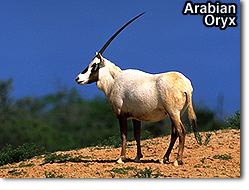Arabian Oryx
 The Arabian oryx (Oryx leucoryx ) once roamed the entire Arabian Peninsula and as mentioned earlier, it became extinct as a wild species in the early 1960's. However, H.H. Sheikh Zayed bin Sultan al Nahyan had a few captive animals that bred well, and today there are several herds at various locations in the emirate of Abu Dhabi. Its precise natural range within the United Arab Emirates is not clear but they were probably found in and around the Liwa, as well as on the plains adjacent to the mountains that stretch to the northern Emirates. They are the largest of the Arabian antelopes and are creatures of the open desert being able to live in areas without trees or standing water. Instead they rely on the moisture obtained from their food and can conserve water by a special adaptation of their kidneys.Their bodies are distinctly white, whilst their legs are clearly marked dark brown as far as the last joint above their hoofs, with the last part to the hoofs being white. The tail is black-tipped and they have distinct dark facial markings that extend down to the lower part of the neck. The white body colour helps to deflect the sunlight. The skin below the hair however is dark and acts as a barrier against ultra-violet rays. Both male and female carry a pair of symmetrical horns, very slightly curved to the back. As the horns of a healthy animal are so symmetrical that they appear as one if seen in profile, it is assumed that the oryx was the origin of the legendary unicorn. The horns can grow to a length of 90 cms, and their sharp points are deadly weapons amongst bulls that are fighting for superiority in a herd. They can have calves all year round, with peaks in spring and autumn. The cow has only one young at a time. When born, it is sandy-brown in colour which blends in superbly with its natural habitat. During the first days of its life, the oryx calf lies in a shallow scrape for most of the day, relying on its camouflage to avoid predators, and only when it is able to keep up with the herd will it follow the mother throughout the day. The Arabian oryx (Oryx leucoryx ) once roamed the entire Arabian Peninsula and as mentioned earlier, it became extinct as a wild species in the early 1960's. However, H.H. Sheikh Zayed bin Sultan al Nahyan had a few captive animals that bred well, and today there are several herds at various locations in the emirate of Abu Dhabi. Its precise natural range within the United Arab Emirates is not clear but they were probably found in and around the Liwa, as well as on the plains adjacent to the mountains that stretch to the northern Emirates. They are the largest of the Arabian antelopes and are creatures of the open desert being able to live in areas without trees or standing water. Instead they rely on the moisture obtained from their food and can conserve water by a special adaptation of their kidneys.Their bodies are distinctly white, whilst their legs are clearly marked dark brown as far as the last joint above their hoofs, with the last part to the hoofs being white. The tail is black-tipped and they have distinct dark facial markings that extend down to the lower part of the neck. The white body colour helps to deflect the sunlight. The skin below the hair however is dark and acts as a barrier against ultra-violet rays. Both male and female carry a pair of symmetrical horns, very slightly curved to the back. As the horns of a healthy animal are so symmetrical that they appear as one if seen in profile, it is assumed that the oryx was the origin of the legendary unicorn. The horns can grow to a length of 90 cms, and their sharp points are deadly weapons amongst bulls that are fighting for superiority in a herd. They can have calves all year round, with peaks in spring and autumn. The cow has only one young at a time. When born, it is sandy-brown in colour which blends in superbly with its natural habitat. During the first days of its life, the oryx calf lies in a shallow scrape for most of the day, relying on its camouflage to avoid predators, and only when it is able to keep up with the herd will it follow the mother throughout the day.
|